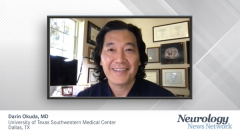
Long-Term Outcomes With Ozanimod Based on Number of MS Relapses
A multiple sclerosis expert, Dr Darin Okuda reviews long-term outcomes with ozanimod in DAYBREAK trial based on the number of relapses that was presented at EAN 2022.
Episodes in this series

Darin Okuda, MD: There were data that were presented at the European Academy of Neurology Congress Meeting in 2022, specifically a piece of work titled Long-term Efficacy and Safety Including COVID-19 Outcomes, Among Ozanimod- Treated Participants With Relapsing Multiple Sclerosis in the DAYBREAK Open-Label Extension Trials. This was a very important piece of work. What it ultimately did was look at participants involved in the early phase 3 trials SUNBEAM [NCT02294058] and RADIANCE [NCT02047734]. These were trials in which participants were randomized to 0.46 mg or 0.92 mg of ozanimod for greater than or equal to 12 months or 24 months. What this work aimed to do was to look at the experience of those in the DAYBREAK trial [NCT04963231]. This is an open-label extension in which all participants receive 0.92 mg of ozanimod, and what they really wanted to understand in terms of the objectives and the aims was the longer-term experiences for those individuals exposed to ozanimod.
Regarding the results, what they did identify within this study was that for all the participants, including those who relapsed both within SUNBEAM and RADIANCE—so within the randomized component of these family studies—there were clinical and radiologic benefits amongst those participants treated with ozanimod for up to 48 months within DAYBREAK. What this tells you is that the effect of this treatment was long-lasting. It carried forward beyond the randomized studies.
They also identified that all participants who had relapsed within the original trials collectively had lower annualized relapse rates within the open-label extension period. As expected, participants who were initially randomized to interferon therapy were switched from interferon to ozanimod in DAYBREAK because all participants received a 0.92 mg dose, which is the current FDA dose of ozanimod. Irrespective of whether they had relapsed in SUNBEAM or RADIANCE, they did have decreases, in contrast, enhancing lesions, newer enlarging T2 lesions throughout DAYBREAK month 48. That was very exciting to see.
I also believe it’s important to highlight that the annualized relapse rates during the open-label extension were higher amongst participants who had relapsed during the original trials compared with those who had not relapsed. This suggests that those individuals that have relapses are at greater risk of having subsequent relapses and sometimes the treatments that we use may not hold all these relapses at bay. That’s also a major takeaway from this work.
Transcript edited for clarity
Newsletter
Keep your finger on the pulse of neurology—subscribe to NeurologyLive for expert interviews, new data, and breakthrough treatment updates.







